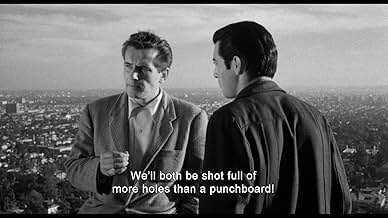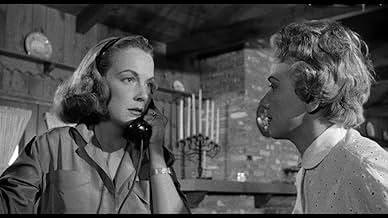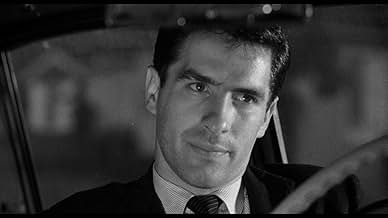CALIFICACIÓN DE IMDb
6.3/10
1.2 k
TU CALIFICACIÓN
Un grupo de delincuentes convictos se apoderan de una casa de los suburbios para escapar de la persecución policial en curso, convirtiendo la vida de la familia que vive allí en una pesadill... Leer todoUn grupo de delincuentes convictos se apoderan de una casa de los suburbios para escapar de la persecución policial en curso, convirtiendo la vida de la familia que vive allí en una pesadilla.Un grupo de delincuentes convictos se apoderan de una casa de los suburbios para escapar de la persecución policial en curso, convirtiendo la vida de la familia que vive allí en una pesadilla.
- Dirección
- Guionista
- Elenco
Eddie Marr
- Captain Cole
- (as Edward Marr)
Stanley Andrews
- Mr. Courtier
- (sin créditos)
Tom Coleman
- Reporter
- (sin créditos)
Oliver Cross
- Detective
- (sin créditos)
Roy Damron
- Detective
- (sin créditos)
Charles Herbert
- Steven Courtier
- (sin créditos)
- Dirección
- Guionista
- Todo el elenco y el equipo
- Producción, taquilla y más en IMDbPro
Opiniones destacadas
These types of films seemed to be quite common in the 1950s. Drivers making the foolish mistake of picking up the worst possible type of hitch-hiker--a criminal. One who might take him hostage or kill him at any moment. A very real fear of the possible.
This film feels like a mix of THE HITCH-HIKER and THE DESPERATE HOURS but isn't quite on par with either. Unlike those, this feels like a Made For TV film. The Narration is very much a negative and will probably make many laugh due to its dire seriousness.
But the characters in this film are well-played and certainly entertaining enough to make this film an enjoyable ride. Especially good are Hildy Parks as the terrorized wife who won't stand for it and Jack Kelly as her husband who is thinking only of his family's welfare. John Cassavetes is also good in his role as the mastermind criminal. There's some terrific cinematography in the film featuring scenes out in the desert and the climatic ending in the rain.
This film feels like a mix of THE HITCH-HIKER and THE DESPERATE HOURS but isn't quite on par with either. Unlike those, this feels like a Made For TV film. The Narration is very much a negative and will probably make many laugh due to its dire seriousness.
But the characters in this film are well-played and certainly entertaining enough to make this film an enjoyable ride. Especially good are Hildy Parks as the terrorized wife who won't stand for it and Jack Kelly as her husband who is thinking only of his family's welfare. John Cassavetes is also good in his role as the mastermind criminal. There's some terrific cinematography in the film featuring scenes out in the desert and the climatic ending in the rain.
Gritty little suspenser that holds interest throughout. Writer-director Andrew Stone's and wife Virginia's reputation rests on a documentary-style approach to film-making. Making a movie about people on board a sinking ship?-- then sink an actual ship, The Last Voyage (1958). I believe it was Andrew Sarris who observed that it was a good thing they never made a film about the end of the world!
There's a lot of that documentary approach in this low-budgeter taken from an actual kidnapping case of the period. Kidnapping was much in the news in 1953 with the sensational abduction for ransom of little Bobby Greenlease, of Kansas City, I believe. And, of course, then as now, screen-writers love to chase the headlines of the day. So it's no surprise that several of these plot-lines turned up at about the same time, including the rather eerie Big House, USA (1955).
Here the screenplay recreates the abduction of the offspring of a wealthy LA-area family, Gene Couture. What makes the movie work is the inspired casting (probably a happy accident) that brings together three fast-rising young actors-- a sullen Vince Edwards, a moody John Cassavetes, and an appealing Jack Kelly as the victim. You really get the feeling from the former two-- who look edgy and act even edgier-- that anything can happen at any time. Together as the lead abductors, they're little short of the proverbial dynamite. When they take Kelly into the desert, you get the feeling he's a dead duck for sure.
Then too, the Stone's insistence on real suburban locations lends the proceedings a look and feel different from the usual. The procedural part gets kind of draggy as the cops enter the case and was likely inspired by the police mega-hit of the day, Dragnet. But at least it's consistent with the over-all documentary tone. Some buffs see the movie as noir. I don't, taking it instead as a particularly effective example of the "home invasion" genre that was also popular at the time. But however you cut it, this is still a darn good little 90 minute nail-biter.
There's a lot of that documentary approach in this low-budgeter taken from an actual kidnapping case of the period. Kidnapping was much in the news in 1953 with the sensational abduction for ransom of little Bobby Greenlease, of Kansas City, I believe. And, of course, then as now, screen-writers love to chase the headlines of the day. So it's no surprise that several of these plot-lines turned up at about the same time, including the rather eerie Big House, USA (1955).
Here the screenplay recreates the abduction of the offspring of a wealthy LA-area family, Gene Couture. What makes the movie work is the inspired casting (probably a happy accident) that brings together three fast-rising young actors-- a sullen Vince Edwards, a moody John Cassavetes, and an appealing Jack Kelly as the victim. You really get the feeling from the former two-- who look edgy and act even edgier-- that anything can happen at any time. Together as the lead abductors, they're little short of the proverbial dynamite. When they take Kelly into the desert, you get the feeling he's a dead duck for sure.
Then too, the Stone's insistence on real suburban locations lends the proceedings a look and feel different from the usual. The procedural part gets kind of draggy as the cops enter the case and was likely inspired by the police mega-hit of the day, Dragnet. But at least it's consistent with the over-all documentary tone. Some buffs see the movie as noir. I don't, taking it instead as a particularly effective example of the "home invasion" genre that was also popular at the time. But however you cut it, this is still a darn good little 90 minute nail-biter.
THE NIGHT HOLDS TERROR is an interesting thriller/film noir entry for various reasons. Yes, it bears a strong similarity to THE DESPERATE HOURS, but that's because both were inspired by the same true (and sensational) story. Proving which one went into production first might be difficult. But really, it doesn't matter, because unlike the Hollywood sheen of THE DESPERATE HOURS, this odd little film has many gritty aspects and colorings and transcends its low budget.
John Cassavetes is always great to watch, even in a lesser picture. Here, while he rarely truly shines, he manages to keep tightly wound like a coiled spring, with his menacing glare and occasional flashes of violence. Vince Edwards is actually nowhere near as good here as he was playing similar hoods in MURDER BY CONTRACT, CITY OF FEAR and THE KILLING, though it's an acceptably menacing performance.
What really makes THE NIGHT HOLDS TERROR is a constant reliance on real locations. I couldn't spot one studio set in the entire picture; every interior seems to be in a real place (Cassavetes' modern hilltop home and the Courtiers' kitchy suburban one, police stations, telephone switching centers, the Mojave desert, etc.). There is even one standout sequence where the captors' car careens through the desert, photographed by what appears to be a cameraman barely holding onto the hood of the car. No rear screen here, and this is several years before the famed from-the-hood Venice driving sequence in TOUCH OF EVIL.
And the pace of the picture is practically amphetamine-charged. If the camera isn't moving, the cast always is, with constant dialogue shot through with tension. This is a strong, underrated thriller, and while hardly a perfect masterpiece, it's definitely superior to stagier hostage dramas of the period and well worth tracking down.
John Cassavetes is always great to watch, even in a lesser picture. Here, while he rarely truly shines, he manages to keep tightly wound like a coiled spring, with his menacing glare and occasional flashes of violence. Vince Edwards is actually nowhere near as good here as he was playing similar hoods in MURDER BY CONTRACT, CITY OF FEAR and THE KILLING, though it's an acceptably menacing performance.
What really makes THE NIGHT HOLDS TERROR is a constant reliance on real locations. I couldn't spot one studio set in the entire picture; every interior seems to be in a real place (Cassavetes' modern hilltop home and the Courtiers' kitchy suburban one, police stations, telephone switching centers, the Mojave desert, etc.). There is even one standout sequence where the captors' car careens through the desert, photographed by what appears to be a cameraman barely holding onto the hood of the car. No rear screen here, and this is several years before the famed from-the-hood Venice driving sequence in TOUCH OF EVIL.
And the pace of the picture is practically amphetamine-charged. If the camera isn't moving, the cast always is, with constant dialogue shot through with tension. This is a strong, underrated thriller, and while hardly a perfect masterpiece, it's definitely superior to stagier hostage dramas of the period and well worth tracking down.
Saw "The Nite Holds Terror" in 1956. Enjoyed it so much I wanted to see it again, but it was showing for just 2 or 3 days in my small home town. I don't recall it ever coming to nearby towns or being listed on tv and wondered why. Perhaps because the Humphrey Bogart version called "The Desperate Hours" garnered a larger following. Did not see the Bogart version until June 2002 and even after 40 years I see the remarkable similarities. I think the pictures were equally as good. Thank you.
A gritty kidnapping caper (complete with no-nonsense, "Dragnet"-style narration) that turns into a documentary-style police procedural as the cops begin to close in. After a sensational beginning--featuring a carjacking, a home invasion, and a very terrified family--the movie begins to lose some steam in the second half (there are lots of shots of hard-working, real-life police dispatchers and telephone operators), but you'll still want to hang on till the end. With a very young John Cassavetes and a pre-"Ben Casey" Vince Edwards as two of the thugs. Based on actual events.
¿Sabías que…?
- TriviaBased on a true story that happened in February 1953.
- ErroresIn the extended scene where Robert Batsford is in a telephone booth inside the Thrifty Drug Store, a member of the camera crew's reflection can be seen on the glass side throughout.
- Créditos curiososThe five lead actors not only receive optical billing in the opening credits, but the narrator speaks both their actual names and their characters' names.
- ConexionesFeatured in Los Angeles Plays Itself (2003)
- Bandas sonorasEvery Now and Then
Written by Virginia L. Stone (as Virginia Stone)
Selecciones populares
Inicia sesión para calificar y agrega a la lista de videos para obtener recomendaciones personalizadas
- How long is The Night Holds Terror?Con tecnología de Alexa
Detalles
- Tiempo de ejecución1 hora 26 minutos
- Color
- Relación de aspecto
- 1.85 : 1
Contribuir a esta página
Sugiere una edición o agrega el contenido que falta

Principales brechas de datos
By what name was Terror en la noche (1955) officially released in India in English?
Responda



























